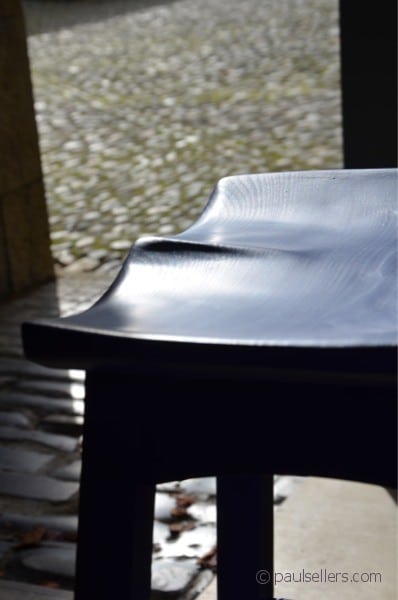Sketch your vision
You see it in your mind’s eye or in a cafe
I saw a chair in Nero’s cafe when I was in a business meeting and thought “that’s a unique concept.” The chair was quite modern and newly made as a part of a batch of chairs. It wasn’t so much that the chair stood out design-wise, but that as a maker I recognised aspects of the design that were, well, clever. A few days later, on Sunday, I met a friend who deals in secondhand and antique furniture pieces and when he opened up the back of his van he had three pieces in there that I liked. One of the pieces was a chair type I had been looking for that was like and old antique one I already have in my kitchen. That chair has some bent oak that formed the seat frame in a continuous semicircle 18″ in diameter. I realised that the bend on this 100-year old chair mirrored one feature I had seen in Nero’s but my new old chair predated the Nero’s chair by a hundred years. The bend was in full 1″ thick oak 3″ wide. The comparable chair had like form and for £20 and a little elbow grease, some small repair work and a some refinishing, the chair would be well worth investing in if only for the comfort this type of chair gives. Anyway, instead if sketching what I saw, I bought the chair.

My advice to anyone is to start somewhere and in a week, a month or even a year and more you will look back and remember the salient details of what you recorded in a sketch as if it were yesterday.
Designing almost everything we make is governed by different elements. These elements almost always revolve around our humanity and as such become critical to the various aspects of the design process. If what we are making is to fit our humanity, then in any design brief this becomes number one in critical design.
Consider every aspect of the who’s, what’s, where’s and why’s. If it must fit the human form then think through all of the parameters and the specifics of the people or person who will use the outcome of your concept.
Regardless of whether a piece is intended for a specific place in a home or office, purpose becomes the next serious element. Creating something fit for purpose means fully understanding its intended use. Sketches help here to and especially so when accompanied by notes.
Space and the limits within we work
Consider every aspect surrounding the piece you are designing. This includes the intended use, space limitations, materials, sizing and proportion, weight and strength and so on. make notes you can rely on.
Another important element of design is the space the piece or collection of pieces will occupy. Space inevitably involves the relational aspects of how the piece and surrounding pieces interrelate with one another. Some furniture pieces, chairs for instance, are moving pieces, others are fixed by bulk, weight and mass while others are simply permanent and designed to that end.

Weigh up the allocated space carefully and weigh the concept you have in relation to the existing pieces. Whatever you make, usually, not always, must complement what is already there. Space is a premium in almost every place that humanity exists. Once it’s occupied, the space is spent.
As crafting artisans form is usually developed as a means to a functional end. a sideboard six feet tall loses its function but when it’s six feet wide it makes total sense. Plastic laminate and granite countertops are truly practical in kitchens whereas stretched ostrich skin makes no sense at all. these are limitations we work with to enhance our humanity. Often, craftspeople want to be artists too. Here they hybridise two worlds to unite concepts they feel will enhance both what they make and the life of others seeing what they have made too. Visual concepts then take on additional elements designed to make an impression.
Investigate and explore where you feel the limitations should begin and end. drawings and sketches can really help you with this. Someone wrote of my scalloped seat that it was a Sam Maloof design. I think the design was around for three centuries before Sam Maloof gave us the Maloof chair as was the case with the Nero chair I spoke of at the beginning. The Maloof seat and the Paul Sellers’ seat were designed to fit the human bottom It’s what makes the chair comfortable and the fact that it looks comfortable enhances the aesthetic appeal of the chair. The real appeal Of the Maloof chair was the unique concept of the design surrounding the methods of construction. So, in essence, several functional aspects of his chair determined the form. The chair was designed to support the human form and that is where I am at with my simple bar stool that is actually a bench stool now and as such fits me, fits my bench and fits my work.
The bench stool is an upcoming project on woodworkingmasterclasses.com. Visit here for a free subscription to see what we are doing with our online broadcast and of course our courses on traditional hand tool woodworking.




I started a kitchen bar stool three days before you started this series of articles. I look forward to the masterclasses series so I can see how you deal with challenges similar to what I encountered. Should be fun!